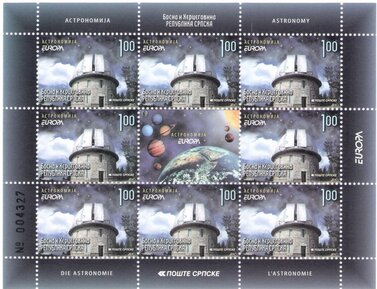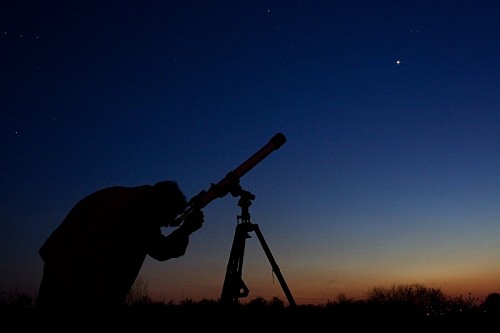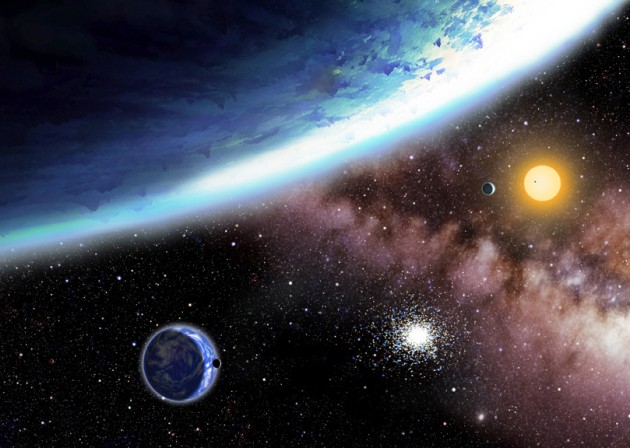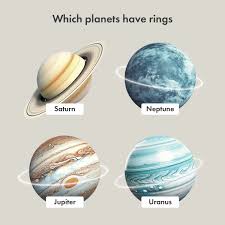Mini Sheet: Observatory (Bosnia and Herzegovina, Serbian Admin 2009)
Observatory (Bosnia and Herzegovina, Serbian Admin 2009)
23 April (Bosnia and Herzegovina, Serbian Admin ) within release Europa (C.E.P.T.) 2009 - Astronomy goes into circulation Mini Sheet Observatory face value 8*1 Bosnia and Herzegovina convertible mark
| Mini Sheet Observatory in catalogues | |
|---|---|
| Michel: | Mi: BA-SR 461KB |
Mini Sheet is square format.
Also in the issue Europa (C.E.P.T.) 2009 - Astronomy:
- Booklet - Europa (C.E.P.T.) 2009 - Astronomy face value 9;
- Mini Sheet - Observatory face value 8*1;
- Stamp - Observatory face value 1;
- Stamp - Observatory face value 1;
- Mini Sheet - Telescope face value 8*2;
- Stamp - Telescope face value 2;
- Stamp - Telescope face value 2;
Mini Sheet Observatory it reflects the thematic directions:
An astronomer is a scientist in the field of astronomy who focuses their studies on a specific question or field outside the scope of Earth. They observe astronomical objects such as stars, planets, moons, comets and galaxies – in either observational (by analyzing the data) or theoretical astronomy. Examples of topics or fields astronomers study include planetary science, solar astronomy, the origin or evolution of stars, or the formation of galaxies. A related but distinct subject is physical cosmology, which studies the Universe as a whole
Astronomy is a natural science that studies celestial objects and the phenomena that occur in the cosmos. It uses mathematics, physics, and chemistry in order to explain their origin and their overall evolution. Objects of interest include planets, moons, stars, nebulae, galaxies, meteoroids, asteroids, and comets. Relevant phenomena include supernova explosions, gamma ray bursts, quasars, blazars, pulsars, and cosmic microwave background radiation. More generally, astronomy studies everything that originates beyond Earth's atmosphere. Cosmology is a branch of astronomy that studies the universe as a whole. .
A globe is a spherical model of Earth, of some other celestial body, or of the celestial sphere. Globes serve purposes similar to maps, but, unlike maps, they do not distort the surface that they portray except to scale it down. A model globe of Earth is called a terrestrial globe. A model globe of the celestial sphere is called a celestial globe
A planet is a large, rounded astronomical body that is generally required to be in orbit around a star, stellar remnant, or brown dwarf, and is not one itself. The Solar System has eight planets by the most restrictive definition of the term: the terrestrial planets Mercury, Venus, Earth, and Mars, and the giant planets Jupiter, Saturn, Uranus, and Neptune. The best available theory of planet formation is the nebular hypothesis, which posits that an interstellar cloud collapses out of a nebula to create a young protostar orbited by a protoplanetary disk. Planets grow in this disk by the gradual accumulation of material driven by gravity, a process called accretion.
A star is a luminous spheroid of plasma held together by self-gravity. The nearest star to Earth is the Sun. Many other stars are visible to the naked eye at night; their immense distances from Earth make them appear as fixed points of light. The most prominent stars have been categorised into constellations and asterisms, and many of the brightest stars have proper names. Astronomers have assembled star catalogues that identify the known stars and provide standardized stellar designations. The observable universe contains an estimated 1022 to 1024 stars. Only about 4,000 of these stars are visible to the naked eye—all within the Milky Way galaxy.





